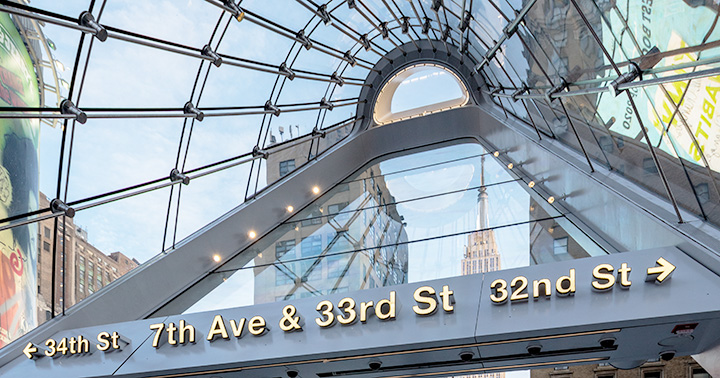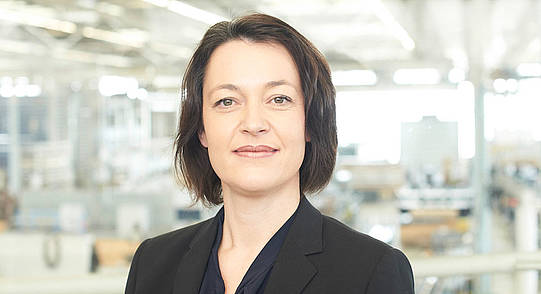Arising beauty: Double-curvature cable net façade for the iconic new entrance to Penn Station in New York City
On normal days, some 650,000 people pass through this transport hub located below the famous Madison Square Garden. To ease congestion, MTA C&D (Metropolitan Transportation Authority Construction & Development), together with Vornado Realty Trust commissioned a new, spacious main entrance. The structure consisting of steel frame and stainless steel cables appears delicate and creates the impression of a dematerialized glass enclosure. Daylight floods through to illuminate the route down to the concourse below.
The idea behind the design continues through to the opening at the concourse level below ground. Lining the oval opening here are 60 mild steel panels in double curvature suspended from the structure. The result looks like a funnel that creates a seamless transition to the outside world above, apparently extending to infinity. Passengers leaving the station via these escalators enjoy an unobstructed view of the Empire State Building through the glass canopy.
Maximum precision for 105 t of steel
The cable net façade designed by seele consists of a steel frame and a network of longitudinal and transverse stainless steel cables tensioned against each other. The primary loadbearing structure is in the form of a 14.6m high steel A-frame. At ground level the “horseshoe” edge beam, about 30m long x 13m wide, forms the structure for anchoring the cables. The complete steel structure is made up of five welded box beams, one transverse beam and the “crown” mounted on top of the A-frame, which was milled from a solid piece of 400 m thick steel. The cables for the façade are anchored here and all jacking work was carried out at the crown.
A total of 105 t of steel was required for the main frame. All of the steelwork is permanently exposed to the weather. Therefore, all surfaces and weld seams had to be finished to the highest standards and comply with the American AESS 4 specification. Access to the openings for the stainless steel cables is difficult, which presented another challenge. Numerous elements supplied by others for rainwater drainage and lighting had to be integrated and their connections to the steelwork taken into account.
In order to achieve the slope of the entrance as intended by the architects, the A-frame was fabricated such that only after tensioning the cables would the structure assume its final 45° position and overall height of 12m. To do this, the longitudinal cables were given a very high prestress in order to achieve a corresponding tension in the transverse cables as well. To ensure trouble-free construction in the heart of New York, the entire steel structure was installed and tested at seele pilsen in the Czech Republic before being shipped to New York for final and permanent assembly by seele and Skanska USA Civil NE.
Construction in downtown Manhattan
Expert coordination of the building work was necessary for this confined site in the middle of Manhattan. Therefore, every element was delivered just in time. seele installed the huge steel frame in three weeks. After that, the individual cables were attached, extended with adapters and tensioned so that the frame would assume its final position. The glazing was then installed. Nearly 140 double-curvature and five flat laminated safety glass panes were shipped from Europe to the NYC site and attached to the cables with special mountings. Every pane is unique, because the SGP interlayers are printed with different patterns of dots. The final pane of glass was attached to the cable structure in November 2020.
Digital façade monitoring
Another ingenious aspect of this project is the monitoring concept devised by seele. The forces in the cables had to be measured, and seele implemented this as a cloud-based solution. Various factors, e.g. short distances between cable nodes and the difficulty of access at this very busy station, made conventional measurement of the forces virtually impossible in this project. During construction, concealed measuring points on the structure collected data for the prestressing of the longitudinal and transverse cables. It was therefore unnecessary to carry out elaborate measurements on site, and measurements can also be made in the future if necessary.
Opening at the turn of the year
The new entrance at 33rd Street, opened on schedule on December 31, 2020, one day before the opening of the Moynihan Train Hall, the extension of Penn Station. For the Moynihan Train Hall, seele was responsible for the execution of over 5,000 sqm of steel and glass roof construction. The cable net façade at the East End Gateway, is yet another remarkable project that seele has completed in this US city.

The new direct entrance to the LIRR concourse at Penn Station on 33rd Street in New York features a remarkable, double-curvature cable net façade. © Field Condition
